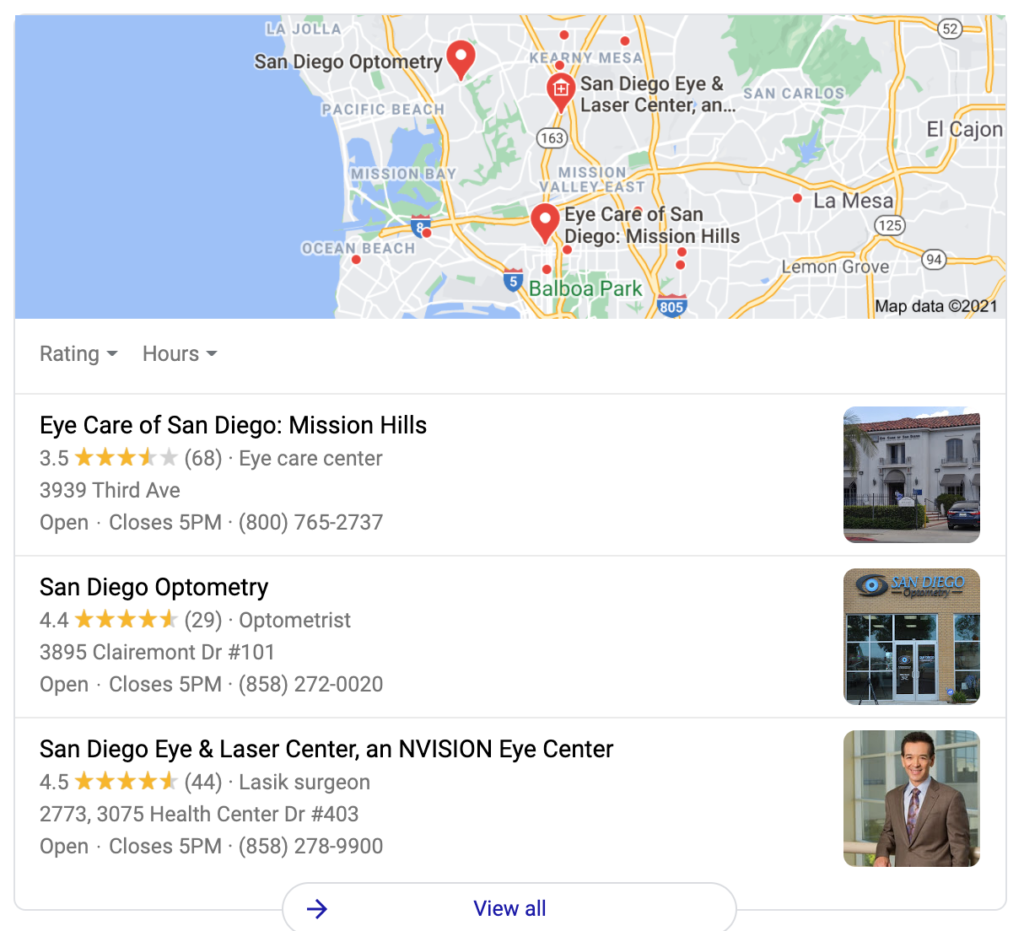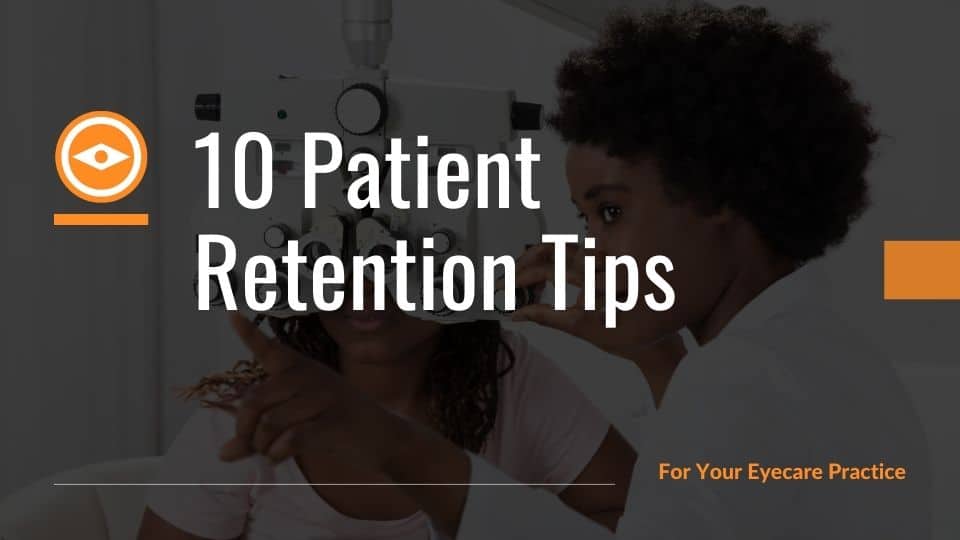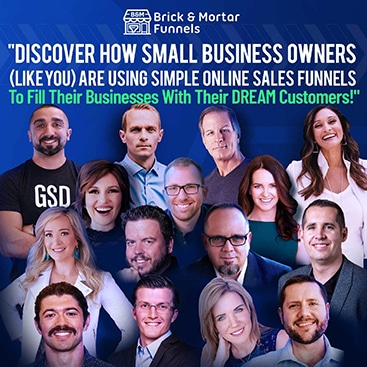What’s your eye care patient retention rate? What system(s) do you have in place to retain your eye care patients?
Do you even have a system?
According to recent marketing statistics, it costs at least 5x more to acquire a new patient than to retain an existing one.
Here’s another astounding statistic…
If you increase your patient retention by just 5%, you can increase your profits by up to (wait for it)…
95%!*
Wait, WHAT?
Yes, it’s true!
So, if you’d like to discover how to increase your profits by 95%, check out the rest of this article…
10 tips on patient retention or, more plainly stated, 10 tips on how to keep your patients from leaving your practice!
Most EMR software products have the ability to make these recommendations possible.
- Implement Retention Scheduling: One of the most important “quick-win” tips I give my clients immediately is to have them train their staff to talk about the importance of ANNUAL eye care and to pre-appoint EVERY patient for their annual eye exams (unless, of course, they need more frequent follow-up care) before they leave the office. Also:
- Make sure that your scheduling team answers the phone as quickly as possible – it’s imperative for the reputation of your practice to NOT send your patients/prospective patients to an automated voice messaging system.
- Before your patients leave their appointment, or before you hang up the phone after they’ve scheduled their appointments, make sure to ask them if there is anyone else in their household that are due for their annual eye exam. For example, if Mrs. Jones just completed the scheduling process, say to her “Mrs. Jones, we are looking forward to seeing you/meeting you at your appointment on [date/time], before we hang up, is there anyone else in your household that’s due for their annual eye exam that you’d like to schedule now?”
- Make sure to call your pre-appointed patients at least 1-3 weeks before their scheduled appointment to confirm them, then again at 1-3 days prior. If they cancel and or no-show for their appointment, make sure to also send them a postcard about 1-2 weeks after the scheduled appointment (yes, mailing pieces is having a come-back in marketing).
- Innovate Appointment Confirmations: Have your scheduling team find out the preferred method of contact – is it text, email, phone, or mail?
- There are newer automation technologies that allow for connecting your scheduling software to appointment reminders that still feel as though they are connecting to a human.
- Don’t forget to use these opportunities to add information about what sets you apart from your competition with your unique problem-solving (sub)specialties.
- Educate Your Patients, Train Your Team: Take every opportunity to educate your patients and train your staff on the importance of annual eye exams, proper eye care, and lifestyle eyewear; also how your (sub)specialties can solve specific vision and ocular health issues, and why YOU’RE the right choice to provide exceptional eye care! Remember to Always Be Communicating (ABCs) to your patients and staff. Some of these patient education opportunities occur:
- During their first interaction with your office (via phone call, marketing messages, referrals, etc.),
- Upon check-in at the front desk (eg. as with the conversations with your staff or the verbiage on your intake forms),
- While being pretested by your technicians (eg. are they explaining the purposes of the diagnostic instruments and why it’s important to conduct them every year), and
- When you, the doctor, are explaining the results of your exam findings and prescribing their treatment regimens.
- Review Your Online Presence/Platforms: Imagine you’re a prospective ideal patient in a brand new town and you need an eye exam…
- …you immediately go to Google and type into the search field “optometrist” or “eye doctor” + the name of your town. Google reveals to you something called the “3-pack” (I typed in “San Diego eye doctor” and got the image you see below).
- It’s a pretty well-known fact in the marketing world that most people searching the internet will only buy products and services from one of the top three companies on the first page of Google (whether it’s in the 3-pack or the regular organic search below the 3-pack).
- Reputable marketing companies can help guide you on getting authentic 4 and 5-star reviews on Google (an absolute necessity) as well as ranking in the top 3 positions for your location.
- Now try this exercise, type in your information… how do you rank against your competition in the search results? You may be surprised!
- Next, do an audit of your website and social media platforms:
- Are you optimizing them to attract your ideal patients?
- Are you using “search-intent” phrases such as “how”, “why”, and “what”; “buy”; “how much” in your content?
- And, do you include your directions, reviews, and practice hours everywhere? Make sure to add all of this if anything is missing. You MUST include your physical address on the bottom of each website page for Google to even consider placing your site in the 3-pack.
- …you immediately go to Google and type into the search field “optometrist” or “eye doctor” + the name of your town. Google reveals to you something called the “3-pack” (I typed in “San Diego eye doctor” and got the image you see below).
- Let Patients Know Why You’re Different: for example, let them know about…
- The latest technology you use for diagnosing and treating your patients
- Your (sub)specialties and how/why they specifically benefit your patients
- The training you provide your staff for exceptional patient care
- Your community involvement
- Be a Patient for a Day: From start to finish, do the following to find out what your patients experience:
- Call into the office to schedule an appointment
- Observe the appearance and user experience of your location as you approach the office with a different perspective
- Check-in at the front desk and evaluate the onboarding procedures
- Sit in your waiting room and observe your surroundings from that perspective (what do your patients see from the waiting room chairs, what can you place in their line of sight that might help with patient education)
- Have your technicians pre-test you and note how they explain the tests and treat you (of course, they may be a bit nervous providing these tests to their boss!)
- Sit in the examination chair even if you don’t have an associate to perform an eye exam on you; note how the exam room appears from your new perspective – what could you place in your room to add value to the patient experience? Are the instruments and room dust-free and appear new?
- Have the technician escort you to your optical – does your optician obtain all the necessary information to explain their options fully?
- Check out at the front desk – do you feel that everything was explained properly and were you asked to schedule your annual eye exam?
- Did you receive any follow-up information about your exam or other expected communications?
- Most importantly, overall, would you return next year for your annual eye exam? AND, would you refer your friends and family to your practice?
- Make Your Patient Your Focus: Practice active listening and empathy, giving your patients your FULL attention, and making sure to not be thinking about the weekend or even your next patient!
- You want to make sure you’re really understanding their eye care issues – that you’re willing to dig deeper and discover that the symptoms of dry eye are coming from computer vision syndrome, lagophthalmos, or some other underlying condition. Without knowing the true cause, you’ll waste your patients’ time and often, their money if the treatment doesn’t hit the actual problem.
- Communicate the results of their eye exams with empathy and allow the patients to ask questions. Spend just an extra minute or two to allow your patients to feel heard. You’ll be amazed by how much patients appreciate this.
- When you bring your patient out of the exam room and into your optical boutique, patients appreciate it when you gently hand them off to your optician, with specific instructions on what you recommend for their prescription and other eye care needs.
- Following up with patients (or having a member of your team do so) when they need extra care because of a difficult problem or eye health issue is always appreciated.
- The bottom line is this: patients can tell when you care, and they’ll tell their friends and family. Many patients feel like they’re being pushed through doctor’s offices these days with hardly even a moment to discuss their own health issues.
- Be Social: As a local business owner, your community will expect to see you and your practice on social media. Here are some ideas for you to showcase what you do and how you’re involved locally:
- Show off your community involvement – have you sponsored a little league team, do you speak at local chambers of commerce or the Rotary Club, or are you involved in your children’s school?
- Describe your (sub)specialties and how they can benefit your potential patients – it’s incredibly easy to promote your (sub)specialties in the local media and, subsequently, on social media. Bring in your local reporter with their videographer and take them through a typical vision therapy session, or an extensive dry eye evaluation. As much as we think everyone knows that we provide these comprehensive services or how they can help, your community doesn’t know you provide them. And the media LOVES these kinds of stories.
- Have an open house to welcome new patients – celebrate your new patients with an annual gathering (with COVID-19 precautions in place, of course). We found these to be incredibly successful and the word of mouth was amazing. Just imagine the wonderful images and videos you can share of these celebratory occasions on your favorite platform.
- Get personal – Don’t be afraid to let your patients see your personal side, as well as your staff’s (within reason, of course!). You may have heard the old marketing saying, people do business with people they know, like, and trust. Many would argue that maybe the “like” component is not as important, but I believe that it IS in our profession. There’s no quicker way for our patients and prospective patients to move through the journey of finding out who we are, getting to know and like us to get to the trust level than to show them your smiling face on video!
- When You Market to Everyone, You Market to No One: This one is HUGE and is often overlooked.
- Of course, choosing your local demographic certainly is a legitimate choice for a target market. However, when you offer (sub)specialties, you’ll want to determine your ideal patient for that particular specialty or specialties. This could be a real patient or one that you make up. When you do the exercise listed in this link, you’ll start to realize how easy it is to create marketing content to attract the right patients and repel the wrong ones! I teach my eye care clients how to do this exercise in more depth, and how to create content to help attract their ideal patients.
- Something else you’ll want to do is to monitor the statistics of
- Be on Brand: Make sure how you present yourself online is reflected in how you and your staff care for your patients. Most people believe branding is about your logo, your colors, and even the fonts you use in your marketing materials. What branding really is, is how your patients and potential patients perceive you! So how do you control this? In reality, you can’t since you can’t control the minds of your patients. What you can do is make sure you and your staff are clear on how you want your practice represented to your community (the mission, vision, and values) and whether or not everything you present to the public aligns with this representation. You can do this by:
- Of course, truly caring about the health and well-being of your patients – this may sound obvious but, if your heart and the hearts of your staff are not in the right place, it will show up in the actions that we display.
- Continuously looking for innovative ways to show how much you care – new technology, new follow-up procedures, developing systems that expedite processes for your patients and are easy to implement for your staff, etc.
- Do the images in your marketing materials and digital assets (website, business cards, postcards, online and offline advertisements, etc.) reflect and align with your mission, vision, and values and with what you’re discovering to be the perception of you and your office by the community?
- Asking your patients their perceptions about you, your practice, and your staff – questions like “did we meet your needs, did your eye exam meet your expectations, is there anything you expected that we didn’t provide,” and more. You may want to get your staff involved in coming up with questions that might help you understand how patients (and potential patients) perceive you. This can certainly be an anonymous questionnaire or survey.
Remember, it costs a lot more money and time to acquire a new patient than it does to retain a current one. I’ve known that for quite some time now. What I didn’t realize is the magnitude of that increase in retention rate.* Of course, that rate can vary quite a bit for many reasons, but can you imagine if that statistic is true for your practice? It’s not even your gross revenues, it’s your net revenues.
🔶 Grab the PDF slides below (by clicking on the image or the button) for these 10 tips to serve as a reminder when you want to implement them to increase your patient retention rate for your eye care practice.
🔶 You can also check out the video version of the slides on Youtube below…
_______________
*Summary of this information: https://smallbiztrends.com/2014/09/increase-in-customer-retention-increases-profits.html





Leave a Reply